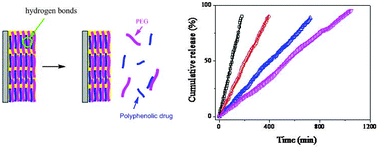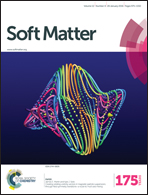Zero-order release of polyphenolic drugs from dynamic, hydrogen-bonded LBL films†
Abstract
Drug carriers capable of releasing drugs at a constant rate, or following zero-order kinetics, can lead to the best control of plasma drug concentration. Here we demonstrated that zero-order release of polyphenolic drugs, including tannic acid, epigallocatechin gallate, proanthocyanidins, and theaflavin-3′-gallate, could be achieved using hydrogen-bonded layer-by-layer films as the drug carrier. The films were fabricated using the polyphenolic drugs as hydrogen donors and polyethylene glycol (PEG) as the hydrogen acceptor. Because the drugs and PEG are bonded with reversible, dynamic hydrogen bonds, the films disintegrate gradually in aqueous solutions, and thus release the drugs into the media. Furthermore, because the PEG polymers have a narrow molecular weight distribution, the films disintegrate and release the polyphenolic drugs at a constant rate. Besides allowing for zero-order release, the drug carrier developed here also provides various ways to tune the drug release rate. The drug release rate increases with decreasing molecular weight of PEG. More importantly, the release rate could be tuned using external stimuli. Increasing the pH or temperature results in accelerated drug release, while the addition of salt retards the drug release.


 Please wait while we load your content...
Please wait while we load your content...